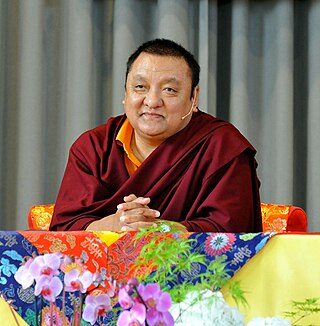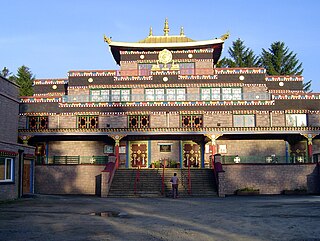Surmang Kagyu
It has been suggested that this article be split into a new article titled Surmang Kagyu . (discuss) (September 2021) |
History
Surmang Monastery (Tibetan : ཟུར་མང་དགོན་པ, Wylie : zur mang dgon pa) was founded about 600 years ago by Trungmase, a student of Deshin Shekpa, the 5th Gyalwa Karmapa. The name in Tibetan means "many cornered" referring to the irregularly shaped reed huts used by the first monastics in the area.

The 1st Trungpa Rinpoche, Kunga Gyaltsen, was a principal student of Trungmase (the 1st Zurmang Gharwang Rinpoche, also well known as Matiratna, or as Lodro Rinchen, which was given by the 5th Gyalwa Karmapa). Small Surmang is the seat of the Surmang Trungpa tulkus, the line of incarnate lamas particularly associated with the sub-complex Dudtsi-til. The Surmang Trungpa Rinpoches was historically the closest students of Trungmase (1st Zurmang Gharwang Rinpoche), along with the eight tongdens (other close students of the founder of the Surmang group). Zurmang Gharwang Rinpoche, Zurmang Tenga Rinpoche and Zurmang Trungpa Rinpoche are together considered the "Three Pillars of Surmang (GharTengTrungSum)."
Accounts of Trungmase and the traditional hierarchy of Surmang differ somewhat. In his autobiography, Born in Tibet, Chogyam Trungpa Rinpoche asserts that Trungmase did not take rebirth, and that the Trungpa tulkus were thereafter traditionally supreme abbots of all of Surmang. However, Trungmase is said to have reincarnated and his line of tulkus is known as the Gharwang tulkus. The Gharwang tulkus have traditionally been the abbots of the main Surmang monastery, Namgyal-tse, and in this role lead the Surmang Kagyu tradition. In 1976 the 16th Gyalwa Karmapa enthroned the 12th Zurmang Gharwang Rinpoche as the 12th incarnation of Trungmase and an emanation of Tilopa. [2]
The Surmang monasteries, through their long history, were exposed to violence. Dudtsi-til Monastery was razed twice by the armies of the Central Government of Tibet, the most recent time being in the 1930s, when the Central Government tried to collect taxes in Tibetan areas of Qinghai.
The Surmang monasteries were again largely destroyed during the Chinese invasion of Tibet and the subsequent Cultural Revolution. [3] [4] [5] In recent years Namgyal-tse has been largely restored under the leadership of the 12th Zurmang Gharwang Rinpoche. Dutsi-til Monastery is being steadily reestablished under the leadership of Sakyong Mipham Rinpoche, the spiritual leader of Shambhala Buddhism and son of Chögyam Trungpa, the 11th Surmang Trungpa. The 2010 Yushu earthquake made it necessary to raze the ancient assembly hall, all of whose costs have been borne exclusively by local support: the monastery, local business community and the Yushu Government. [6] The present regent abbot of Dutsi-til is Aten Rinpoche. The titular head of the monastery is Choseng Trungpa Rinpoche, the 12th Trungpa Tulku.
The three famous Tulkus from Zurmang are well known with the name GharTengTrungSum (Gharwang, Tenga, Trungpa Rinpoche). Zurmang Gharwang Rinpoche II and Zurmang Tenga Rinpoche II are the grandson of TrungMase / Matiratna (1st Zurmang Gharwang Rinpoche).
Surmang Foundation
Surmang Foundation was founded in 1988 by Lee Weingrad following his trip to the region in 1987, making him the first Westerner to visit the region. In 1991, the Foundation went into partnership with the Dutsi Til Monastery and the Qinghai Provincial Government resulting in the construction of a clinic. The agreement, the first one signed by the Chinese Government with a foundation in Qinghai, opened the door for other foundations in Qinghai, most notably the Konchok Foundation. Since 1991 the foundation provides community development and health services to the region, including support of monks, nuns, and visitors to the facilities at the retreat center of Dorje Khyung Dzong. The Foundation was also responsible for the arrangements and logistics of the 2001 visit of Trungpa Tulku XI's son, Sakyong Mipham Rinpoche.












